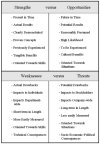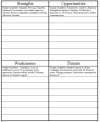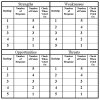- Management Reference Guide
- Table of Contents
- Introduction
- Strategic Management
- Establishing Goals, Objectives, and Strategies
- Aligning IT Goals with Corporate Business Goals
- Utilizing Effective Planning Techniques
- Developing Worthwhile Mission Statements
- Developing Worthwhile Vision Statements
- Instituting Practical Corporate Values
- Budgeting Considerations in an IT Environment
- Introduction to Conducting an Effective SWOT Analysis
- IT Governance and Disaster Recovery, Part One
- IT Governance and Disaster Recovery, Part Two
- Customer Management
- Identifying Key External Customers
- Identifying Key Internal Customers
- Negotiating with Customers and Suppliers—Part 1: An Introduction
- Negotiating With Customers and Suppliers—Part 2: Reaching Agreement
- Negotiating and Managing Realistic Customer Expectations
- Service Management
- Identifying Key Services for Business Users
- Service-Level Agreements That Really Work
- How IT Evolved into a Service Organization
- FAQs About Systems Management (SM)
- FAQs About Availability (AV)
- FAQs About Performance and Tuning (PT)
- FAQs About Service Desk (SD)
- FAQs About Change Management (CM)
- FAQs About Configuration Management (CF)
- FAQs About Capacity Planning (CP)
- FAQs About Network Management
- FAQs About Storage Management (SM)
- FAQs About Production Acceptance (PA)
- FAQs About Release Management (RM)
- FAQs About Disaster Recovery (DR)
- FAQs About Business Continuity (BC)
- FAQs About Security (SE)
- FAQs About Service Level Management (SL)
- FAQs About Financial Management (FN)
- FAQs About Problem Management (PM)
- FAQs About Facilities Management (FM)
- Process Management
- Developing Robust Processes
- Establishing Mutually Beneficial Process Metrics
- Change Management—Part 1
- Change Management—Part 2
- Change Management—Part 3
- Audit Reconnaissance: Releasing Resources Through the IT Audit
- Problem Management
- Problem Management–Part 2: Process Design
- Problem Management–Part 3: Process Implementation
- Business Continuity Emergency Communications Plan
- Capacity Planning – Part One: Why It is Seldom Done Well
- Capacity Planning – Part Two: Developing a Capacity Planning Process
- Capacity Planning — Part Three: Benefits and Helpful Tips
- Capacity Planning – Part Four: Hidden Upgrade Costs and
- Improving Business Process Management, Part 1
- Improving Business Process Management, Part 2
- 20 Major Elements of Facilities Management
- Major Physical Exposures Common to a Data Center
- Evaluating the Physical Environment
- Nightmare Incidents with Disaster Recovery Plans
- Developing a Robust Configuration Management Process
- Developing a Robust Configuration Management Process – Part Two
- Automating a Robust Infrastructure Process
- Improving High Availability — Part One: Definitions and Terms
- Improving High Availability — Part Two: Definitions and Terms
- Improving High Availability — Part Three: The Seven R's of High Availability
- Improving High Availability — Part Four: Assessing an Availability Process
- Methods for Brainstorming and Prioritizing Requirements
- Introduction to Disk Storage Management — Part One
- Storage Management—Part Two: Performance
- Storage Management—Part Three: Reliability
- Storage Management—Part Four: Recoverability
- Twelve Traits of World-Class Infrastructures — Part One
- Twelve Traits of World-Class Infrastructures — Part Two
- Meeting Today's Cooling Challenges of Data Centers
- Strategic Security, Part One: Assessment
- Strategic Security, Part Two: Development
- Strategic Security, Part Three: Implementation
- Strategic Security, Part Four: ITIL Implications
- Production Acceptance Part One – Definition and Benefits
- Production Acceptance Part Two – Initial Steps
- Production Acceptance Part Three – Middle Steps
- Production Acceptance Part Four – Ongoing Steps
- Case Study: Planning a Service Desk Part One – Objectives
- Case Study: Planning a Service Desk Part Two – SWOT
- Case Study: Implementing an ITIL Service Desk – Part One
- Case Study: Implementing a Service Desk Part Two – Tool Selection
- Ethics, Scandals and Legislation
- Outsourcing in Response to Legislation
- Supplier Management
- Identifying Key External Suppliers
- Identifying Key Internal Suppliers
- Integrating the Four Key Elements of Good Customer Service
- Enhancing the Customer/Supplier Matrix
- Voice Over IP, Part One — What VoIP Is, and Is Not
- Voice Over IP, Part Two — Benefits, Cost Savings and Features of VoIP
- Application Management
- Production Acceptance
- Distinguishing New Applications from New Versions of Existing Applications
- Assessing a Production Acceptance Process
- Effective Use of a Software Development Life Cycle
- The Role of Project Management in SDLC— Part 2
- Communication in Project Management – Part One: Barriers to Effective Communication
- Communication in Project Management – Part Two: Examples of Effective Communication
- Safeguarding Personal Information in the Workplace: A Case Study
- Combating the Year-end Budget Blitz—Part 1: Building a Manageable Schedule
- Combating the Year-end Budget Blitz—Part 2: Tracking and Reporting Availability
- References
- Developing an ITIL Feasibility Analysis
- Organization and Personnel Management
- Optimizing IT Organizational Structures
- Factors That Influence Restructuring Decisions
- Alternative Locations for the Help Desk
- Alternative Locations for Database Administration
- Alternative Locations for Network Operations
- Alternative Locations for Web Design
- Alternative Locations for Risk Management
- Alternative Locations for Systems Management
- Practical Tips To Retaining Key Personnel
- Benefits and Drawbacks of Using IT Consultants and Contractors
- Deciding Between the Use of Contractors versus Consultants
- Managing Employee Skill Sets and Skill Levels
- Assessing Skill Levels of Current Onboard Staff
- Recruiting Infrastructure Staff from the Outside
- Selecting the Most Qualified Candidate
- 7 Tips for Managing the Use of Mobile Devices
- Useful Websites for IT Managers
- References
- Automating Robust Processes
- Evaluating Process Documentation — Part One: Quality and Value
- Evaluating Process Documentation — Part Two: Benefits and Use of a Quality-Value Matrix
- When Should You Integrate or Segregate Service Desks?
- Five Instructive Ideas for Interviewing
- Eight Surefire Tips to Use When Being Interviewed
- 12 Helpful Hints To Make Meetings More Productive
- Eight Uncommon Tips To Improve Your Writing
- Ten Helpful Tips To Improve Fire Drills
- Sorting Out Today’s Various Training Options
- Business Ethics and Corporate Scandals – Part 1
- Business Ethics and Corporate Scandals – Part 2
- 12 Tips for More Effective Emails
- Management Communication: Back to the Basics, Part One
- Management Communication: Back to the Basics, Part Two
- Management Communication: Back to the Basics, Part Three
- Asset Management
- Managing Hardware Inventories
- Introduction to Hardware Inventories
- Processes To Manage Hardware Inventories
- Use of a Hardware Inventory Database
- References
- Managing Software Inventories
- Business Continuity Management
- Ten Lessons Learned from Real-Life Disasters
- Ten Lessons Learned From Real-Life Disasters, Part 2
- Differences Between Disaster Recovery and Business Continuity , Part 1
- Differences Between Disaster Recovery and Business Continuity , Part 2
- 15 Common Terms and Definitions of Business Continuity
- The Federal Government’s Role in Disaster Recovery
- The 12 Common Mistakes That Cause BIAs To Fail—Part 1
- The 12 Common Mistakes That Cause BIAs To Fail—Part 2
- The 12 Common Mistakes That Cause BIAs To Fail—Part 3
- The 12 Common Mistakes That Cause BIAs To Fail—Part 4
- Conducting an Effective Table Top Exercise (TTE) — Part 1
- Conducting an Effective Table Top Exercise (TTE) — Part 2
- Conducting an Effective Table Top Exercise (TTE) — Part 3
- Conducting an Effective Table Top Exercise (TTE) — Part 4
- The 13 Cardinal Steps for Implementing a Business Continuity Program — Part One
- The 13 Cardinal Steps for Implementing a Business Continuity Program — Part Two
- The 13 Cardinal Steps for Implementing a Business Continuity Program — Part Three
- The 13 Cardinal Steps for Implementing a Business Continuity Program — Part Four
- The Information Technology Infrastructure Library (ITIL)
- The Origins of ITIL
- The Foundation of ITIL: Service Management
- Five Reasons for Revising ITIL
- The Relationship of Service Delivery and Service Support to All of ITIL
- Ten Common Myths About Implementing ITIL, Part One
- Ten Common Myths About Implementing ITIL, Part Two
- Characteristics of ITIL Version 3
- Ten Benefits of itSMF and its IIL Pocket Guide
- Translating the Goals of the ITIL Service Delivery Processes
- Translating the Goals of the ITIL Service Support Processes
- Elements of ITIL Least Understood, Part One: Service Delivery Processes
- Case Study: Recovery Reactions to a Renegade Rodent
- Elements of ITIL Least Understood, Part Two: Service Support
- Case Studies
- Case Study — Preparing for Hurricane Charley
- Case Study — The Linux Decision
- Case Study — Production Acceptance at an Aerospace Firm
- Case Study — Production Acceptance at a Defense Contractor
- Case Study — Evaluating Mainframe Processes
- Case Study — Evaluating Recovery Sites, Part One: Quantitative Comparisons/Natural Disasters
- Case Study — Evaluating Recovery Sites, Part Two: Quantitative Comparisons/Man-made Disasters
- Case Study — Evaluating Recovery Sites, Part Three: Qualitative Comparisons
- Case Study — Evaluating Recovery Sites, Part Four: Take-Aways
- Disaster Recovery Test Case Study Part One: Planning
- Disaster Recovery Test Case Study Part Two: Planning and Walk-Through
- Disaster Recovery Test Case Study Part Three: Execution
- Disaster Recovery Test Case Study Part Four: Follow-Up
- Assessing the Robustness of a Vendor’s Data Center, Part One: Qualitative Measures
- Assessing the Robustness of a Vendor’s Data Center, Part Two: Quantitative Measures
- Case Study: Lessons Learned from a World-Wide Disaster Recovery Exercise, Part One: What Did the Team Do Well
- (d) Case Study: Lessons Learned from a World-Wide Disaster Recovery Exercise, Part Two
This article presents information on how to use the brainstorming technique known as SWOT (strengths, weaknesses, opportunities, and threats) Analysis. Four different procedures will be used In order to obtain and organize the maximum amount of information in the least amount of time, I use four different procedures during the course of a SWOT Analysis. These four procedures are:
- Round Robin Method to identify items;
- Author/Group Consensus Scheme to merge items;
- Nominal Group Technique to prioritize items;
- Common Threads Approach to categorize items.
Some of you may be familiar with one or more of these procedures, just as some of you may be familiar with the SWOT process in general. For those of you who may not be familiar with SWOT, or any of these four procedures, I will provide a brief description of each of these entities.
SWOT Analysis
SWOT Analysis is a process to identify the relative strengths, weaknesses, opportunities and threats, of a person, a small team, a large organization, an initiative, or a process, normally in a business environment. When conducted in association with various brainstorming procedures, it can offer very meaningful results in just a short amount of time.
During the past two years I conducted nearly a dozen SWOT sessions for a variety of clients, and incorporated small improvements most every time I facilitated such an event. Some of the topics we worked on included a SWOT for a security program, for business continuity, for financial branch openings, for configuration, for offshore programming and for a new company start-up.
Here are a few tips to consider before proceeding with your SWOT. First, select a qualified facilitator to conduct the session. The person should be skilled at controlling the pace and focus of the brainstorming. This is especially important for the round robin portion of the session. Second, narrow your focus to a very specific objective. The more generic your focus, the less effective your session will be. Finally, understand and use the following four procedures. In my experience, the use of these measures greatly enhances the effectiveness of the SWOT Analysis.
Round Robin Method To Identify Items
Round robin is a fast-paced method to quickly identify items during a brainstorming session. When the process is used properly, there is virtually no lost time in gathering meaningful information. The two keys to its success are brevity and hand-offs. Participants sitting around a table are each given a choice to briefly offer a response or to hand off to the next person. Each response is recorded. Typically, only 10-15 seconds are spent on each individual so short quick responses are a necessity. Hand-offs are very common, especially during the first few rounds. Rounds continue until two full passes are made with no new responses. You do not need to offer a response during each round, or only two or three total responses from each person is expected for each category of SWOT.
Participants of SWOTs sometime struggle with differentiating between strengths & opportunities, and between weaknesses & threats. Figure 1 points out some of the key differences between these two groups of responses. These differences should be explained, discussed and re-emphasized for each of the four categories of a SWOT.

Figure 1. Comparison of SWOT Characteristics
Offering some sample qualifiers, such as those shown in Figure 2, before the start of each round of brainstorming tend to stimulate brevity and consistency among responses. This in turn facilitates recording of the responses on flip charts. If your group is larger than 10, I suggest having two scribes alternately recording the responses.

Figure 2. SWOT Sample Worksheet
Author/Group Consensus Scheme To Merge Items
Some responses may turn out to be similar to ones previously mentioned. At the end of each round – for example after all strengths have been identified – all responses for that round should be briefly reviewed for possible merging. I have found that recording the initials of the person offering the response enables the parties involved to come to a consensus as to whether or not a merger is warranted. I refer to this process as the author/group consensus scheme. It looks at those responses that may be merged and negotiates with the author of the response and the group to gain consensus on it.
Nominal Group Technique To Prioritize Items
The nominal group technique (NGT) effectively prioritizes large lists of items in a short time by having each individual apply a point value to just a few of their top choices. What may normally take hours to accomplish with other methods can be done in 10-15 minutes with NGT. The 'Brainstorming Requirements' section of the Process Management portion of this Reference Guide explains the use of this technique in detail. Figure 3 offers a worksheet for use with this method.

Figure 3. SWOT Voting Worksheet
Common Threads Approach To Categorize Items
Once the items have been identified, merged, and prioritized, they can be grouped into major categories according to common threads that stand out from the prioritized lists. This categorizing may occur after the SWOT brainstorming session, and during the analysis of the results and the review of the findings.
The actual analysis consists of inspecting the prioritized list within each category and looking for major groupings. This can lend insight as to not only which response carried the most weight, but by how much they were ahead of the pack. Next, by reviewing the prioritized lists across all four categories, you may be able to spot trends and relationships across the different areas. For example, in one of my recent SWOTs, a distinct distrust of one the support groups became very apparent by making such an analysis.
Upon completion of the final analysis, the completed report should be reviewed with the participates for feedback, discussion and follow-up. This is a good opportunity to ask for feedback on the process itself. It can be surprising how many good suggestion the participants can have to improve the SWOT once they have gone through it once.
